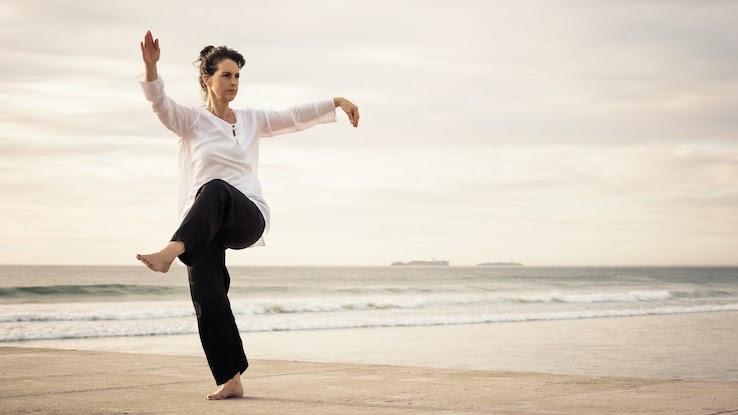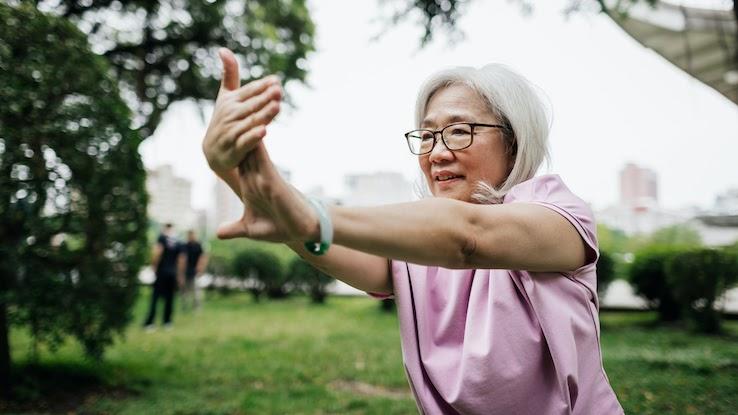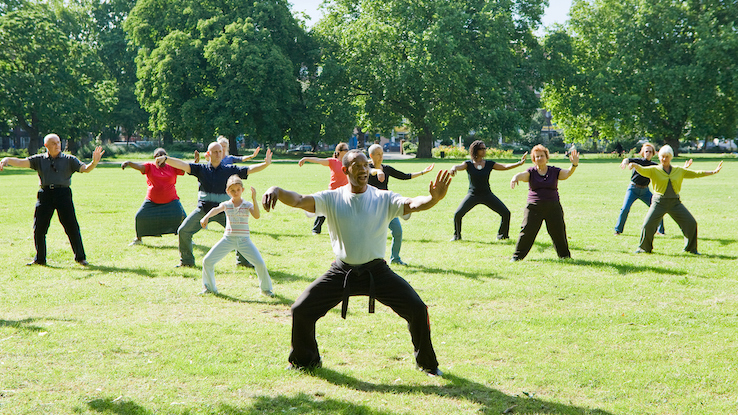
We could all use a little more relaxation in our daily lives — and many of us want to add more movement, too. One easy and enjoyable way to do both is to begin practicing tai chi, a graceful martial arts technique that focuses on deep breathing and slow movements.
Tai chi originated in China several hundred years ago. While it was originally taught as a self-defense technique, it gradually evolved to a slower-paced, gentle exercise that some people refer to as “meditation in motion.” If you’re looking for a low-impact form of exercise that can benefit both your mind and your body — and one that’s great for many different skill and coordination levels — consider trying tai chi. We’ll help you get started with the basics.
What Is Tai Chi Exercise?

Technically, tai chi is an ancient form of martial arts. But, almost everyone who practices it today isn’t training to fight. Over the centuries, the movements practiced in tai chi have become much more fluid and gentle, and people practice its slow, graceful motions as a form of light exercise that doesn’t put too much stress on their joints. In tai chi, you flow from one posture to the next seamlessly in constant, evenly paced motions. If you watch others perform tai chi, you’ll notice that the movements can look like an elegant dance.
A gentle, low-impact, non-competitive exercise, tai chi is safe for practitioners of all ages because it’s easy on muscles and joints. You also don’t require any specific equipment to practice it; some comfortable, loose clothing is really all you need. You can practice tai chi at home or take classes in a studio by simply bringing yourself and a desire to move.
Many people who are drawn to tai chi aren’t only interested in the positive impact it can have on their bodies, but they’re also interested in its mental and spiritual benefits. In this way it’s similar to yoga, another meditative movement practice that involves focusing on your breathing and on mindful motion.
For the most part, tai chi is a relaxing exercise. However, there are some more rigorous forms of the practice that increase in difficulty if you’re interested in advancing this way. In its short form, tai chi includes 27 poses. In its long form, it may consist of 60, 108 or 150 forms. Long-form tai chi tends to be more challenging for your body than its short-form counterpart, and it’s important to learn how to do the postures correctly to ensure safe tai chi practice.
Depending on how rigorous you want your tai chi exercise to be, you can choose from one of its five styles:
- Yang tai chi is great for beginners in that it’s almost always slow. Its movements are large and sweeping.
- Wu tai chi is also practiced slowly, but it emphasizes micro-movements and focuses more on different hand positions.
- Chen tai chi combines slow and fast motions, and it’s best to wait until you have a bit of experience before trying these forms.
- Sun tai chi also combines slow and fast movements, though it’s less demanding on your body.
- Hao tai chi is a less common style that focuses on posture accuracy and combines the Yang and Chen styles.
What Are the Benefits of Tai Chi for Your Body?

Tai chi can benefit both your mind and body in various ways. As a gentle form of movement, it may help with moderate weight loss without putting pressure on your joints and bones. Studies have found that adults who practiced tai chi 45 minutes a day for five days a week lost 1 pound after 12 weeks without any further changes to their lifestyles.
One of the most well-known benefits of tai chi is its ability to reduce stress, anxiety and depression. A 2018 study published in the Journal of Clinical Psychology found that tai chi provided stress-relieving results similar to those of more intense exercise routines. The study results also suggested that, because of the intentional breathwork involved in tai chi, this type of workout may even be better at reducing stress and anxiety than other kinds of exercise. Additionally, a 2019 review of research found that tai chi improved negative emotions in adults of all ages. Experts believe this is because of its positive impact on both our mood-regulating hormones and our nervous systems.
Various studies have also found that tai chi practitioners of all ages may benefit from better sleep quality. This is likely related to tai chi’s ability to ease symptoms of stress and anxiety. Regular exercise in general often helps people get more restful sleep, too.
Despite the gentle nature of this exercise, tai chi can help boost your strength, flexibility, stamina, balance and agility. These qualities are beneficial to your health at any age, but in older adults these qualities can significantly decrease the risk of falling. When older adults feel confident in their mobility, their quality of life tends to increase.
Practicing tai chi may also help to relieve different kinds of pain, including arthritis and back pain. Many people who experience bodily pain tend to steer clear of exercise for fear of injuring themselves even more. Tai chi, being the slower form of movement that it is, seems to have the opposite result.
Basic Tai Chi Motions

There are more than 100 tai chi forms, which are the specific ways you move your body, in total. Once you’ve mastered the basic moves, it gets easier to begin learning some of the more complex ones. The idea is to flow between them and gradually transition from one to the next rather than treat each motion as separate.
Warming up before tai chi practice is important. Beginning with deep breaths in and out will help to center both your mind and body. Following this, you can do slow head rolls in both directions to loosen your neck muscles. Next, try knee circles by standing with your knees and feet together and your knees slightly bent. Then, with your hands on your knees, begin to draw circles with your knees. Last, end with a forward bend. Simply stretch forward, bringing your fingers to your toes and holding this stretch for a few seconds.
Below are two basic tai chi motions to try. One important thing to keep in mind is that this exercise isn’t just about getting to the right position — it’s also about the flow of the movement itself into the next form.
White Crane Spreads Wings: Placing nearly all your weight on your right foot, turn your waist slightly to the right. Then, raise your right hand with your palm facing your body. Your left palm should be facing the ground, and your left heel should be slightly off the ground. In this position, keep coiling your waist to the right.
Snake Creeps Left: Beginning in a standing position, slowly crouch down to a deep hamstring lunge with one knee bent and your other leg straight and out to the side. Extend the arm that’s on the same side of your body as your bent leg straight out to the same side. Press your other arm — the one on the same side as your straightened leg — downward with the palm facing the ground. Remember to do these motions evenly and slowly.
As you get started, you might find that the simplest way to practice is by following along with a tai chi video or going to local tai chi classes to fully see the exact movements and learn how to do them properly. These methods will help you not only get the moves down but will also make it easier to understand the flow of tai chi from one motion to the next.
Resource Links:
“Tai chi: A gentle way to fight stress,” Mayo Clinic
“History of Tai Chi,” UCLA
“The Effects of Twelve Weeks of Tai Chi Practice on Anxiety in Stressed But Healthy People Compared to Exercise and Wait‐List Groups–A Randomized Controlled Trial,” Wiley Online Library
“Effects of tai chi chuan on anxiety and sleep quality in young adults: lessons from a randomized controlled feasibility study,” National Institutes of Health
“Tai chi qigong as a means to improve night-time sleep quality among older adults with cognitive impairment: a pilot randomized controlled trial,” National Institutes of Health
“The Effect of Tai Chi Exercise on the Risk and Fear of Falling in Older Adults: a Randomized Clinical Trial,” National Institutes of Health
“Tai Chi is Effective in Treating Knee Osteoarthritis: A Randomized Controlled Trial,” National Institutes of Health
“T’ai Chi for Chronic Low Back Pain in Older Adults: A Feasibility Trial,” The Journal of Alternative and Complementary Medicine





